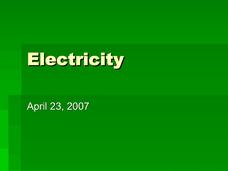Curated OER
Electric Circuits
Learners explore energy by completing an electricity worksheet. In this conductors lesson, students define the energy related vocabulary terms circuit, electronics, conductor and semi-conductor before examining computer chips in class....
Curated OER
Review of Ionic and Covalent Compounds and Transitioning from Ionic to Covalent Compounds
Here is a unique assigment: compare and contrast ionic and covalent compounds in an extensive data table and then analyze Lewis dot structures in antoher. Three columns are to befilled in: "characteristic or feature," "applies to ionic...
Curated OER
What do Atoms Look Like?
In this atoms worksheet, students complete 58 questions about the atomic radius of atoms, the ionization energy, the valence electrons, metals, non-metals and semi-metals and the families of elements.
Curated OER
What do Atoms Look Like?
In this atom worksheet, high schoolers complete 60 questions about the trends in atoms such as ionization energy and atomic radius, about valence electrons, about the families of elements, about metals, non-metals and semi-metals, about...
Curated OER
Conductivity
Students work together to create a simple conductivity tester. They discover the difference between conductors and insulators. They test different types of materials for their conductivity as well.
Chemistry Teacher
Metals, Nonmetals, and Metalloids Lab
What an exciting way to introduce your blossoming chemists to the world of metals, nonmetals, metalloids, and polymers! Here is a lab activity that is designed to allow pupils the opportunity to visualize the reaction of metals,...
Curated OER
Electricity
The presentation begins with a circuit building activity and two data tables for young scientists to copy and complete. Full of clever animations, it will definitely spark student interest! However, the information is incoherent. You may...
Curated OER
Introduction And Brief History of Materials Science
Young scholars develop an understanding of the concept of matter. They l participate actively in the bubble raft experiment as described on the Center for Thermal Spray Research's website. They demonstrate dislocations and grain...
Curated OER
Libros Y Amigos: Publishing Bilingual Books
Young scholars review simple phrases and vocabulary in Spanish. In groups, they create at least one page of a bilingual class book with an illustration. Once the book is completed, they present their page to the class for another...
Curated OER
Electronic Technology
In this electronic activity, students complete 4 short answer, 6 fill in the blank, and 4 term identifications about electronics.
Curated OER
Using Harmonic Vision’s Music Ace Software to Reinforce Basic Music Skills
If you have access to Harmonic Vision’s Music Ace Software, then this lesson could work for you. Kindergarteners use the video music software to place, identify, and read musical notes. They listen in and identify both high and low...
Curated OER
What do Atoms Look Like?
In this atom worksheet, high schoolers answer 31 multiple choice questions about the structure of atoms, the periodic table, the reactivity of elements, orbital diagrams and the families of elements.
Curated OER
Metals, Non-Metals, Metalloids
High schoolers describe properties of various elements. They arrange the elements based on properties in order to explain the organization of the periodic table. They label elements as metal, non-metal, or metalloid.
Curated OER
Leyden Jar: Static Electricity
Students experiment with a Leyden Jar, a device that stores electrical charges. A large voltage can be built up in this jar by adding more and more charge. The modern name for this device is a capacitor.















